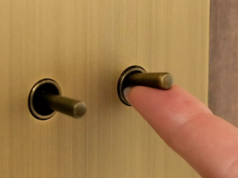
EMI (or electromagnetic interference) can cause a variety of problems with electronic equipment or communications systems. Find out how to prevent this in your home.

Right – the C-tick logo.
Interference
Some electrical gear emits interference – much like you might’ve seen or heard when watching or listening to TV or the radio. The interference is ‘electromagnetic interference’, or EMI for short. EMI is another form of radio wave, identical in nature to those emitted from broadcasting antennas.
Sometimes interference is only slight or temporary, and it doesn’t matter too much – other times though, it’s more than just a nuisance. Common emitters of interference include things like microwave ovens, thermostats switching on and off, and motors in kitchen appliances.
Appliances sold in Australia have to comply with emission regulations. Products that comply with these regulations come bearing the C-tick mark, which indicates that they’ve been tested to the standard set out in regulations laid down by the Australian Communication and Media Authority (ACMA).
Our TV sets and radios are usually equipped with circuitry to shield them from such interference too – but things like pacemakers, apnea (sleep disorder) monitors, and some control gear like sophisticated home automation equipment can be affected too, so interference is a significant issue.
More interference
Some interference effects are not at radio frequencies, but are instead much closer to the frequency at which alternating current operates in powerlines (50Hz, or 50 cycles per second). Without getting too technical, these types of interference cause harmonics, inter-harmonics and flicker.
Harmonics often result from things like fluorescent lighting. It’s not from the tube or lamp itself that causes the problem – it’s the associated ballast. Other sources include electronic dimmers, and computers.
‘Flicker’ is a sudden drop of voltage, and then an increase back to the normal level. Flicker is caused by motors and other current drawing loads as they switch on and off – for example, the blower motor of a gas heater.
This interference occurs directly on the wire circuits to which the devices are connected, and it is also sometimes the result of induction, which (in a simple sense) is caused when certain wires are placed too close to each other.
Getting rid of interference
Eliminating interference can be quite tough! The C-tick mark on your TV, Blu-ray player, radio or other equipment implies that the immunity of these devices to interference is quite high. Interference can affect telecommunication wiring and home automation installations too though. To guard against this, twisted pair wiring is often used. Twisted pair wiring works to cancel out the interference, and while it’s not a perfect cure, it is pretty good.
Crosstalk
You may have experienced crosstalk on occasion on your landline phone, which is also consists of twisted pair wiring. What happens in this case is that a neighbouring twisted pair ‘injects’ a signal.
This unwanted signal mixes with the message being passed from one piece of equipment to another. Proper design of multi-core cable minimises the opportunity for crosstalk – but doesn’t eliminate it entirely. The good news is that your installer can check the wiring using a cable tester to ensure that crosstalk isn’t going to cause a problem.





